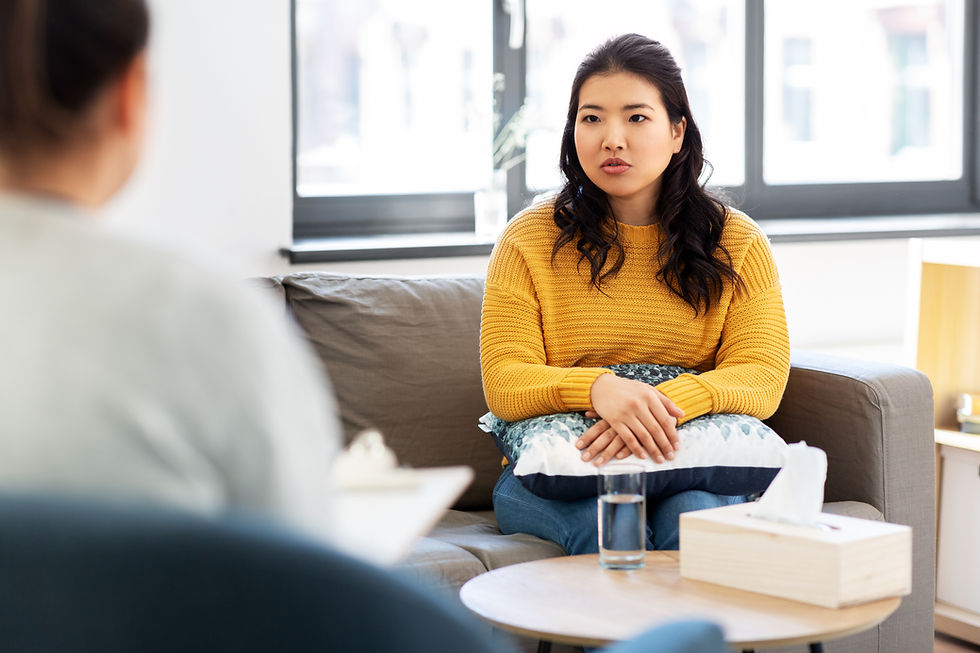How to use Tapping as a Coping Skill
- Lauren Enfroy

- Feb 24, 2022
- 3 min read
Some clients of mine are starting to hear about tapping being used as a coping skill. This sounds odd to many, "What does tapping have to do with my mental health?". I have seen tapping represented in media now, if anyone has watched Jane the Virgin, they certainly remember her vigorously tapping to try and calm her anxiety. While EFT tapping has gained some momentum in the mental health spheres in recent years, I am here to talk about tapping as a form of bilateral stimulation, similar to what is used in EMDR (eye movement desensitization and reprocessing) therapy. And yes, it really is as simple as it sounds.
EMDR therapy is built on the premise of bilateral stimulation (BLS) to cope with difficult situations and emotions, most commonly traumas. BLS works by activating both sides of the brain as we stimulate both sides of our body. We can do this through eye movements (moving only our eyes, not our heads), audio sounds, and tapping. Even walking has been found to be a form of BLS! Research has shown that when we activate both sides of our brain, we are better able to connect our feelings to logic. For example, have you ever felt like you weren't doing well at something, maybe your job, and despite having all of this evidence to the contrary (positive evaluations, verbal praise from a boss or peers, increased productivity) you still felt like you weren't doing well? I'll hear clients say things like "I know that this is not true, but it still feels like it is" to me quite often in therapy. This is what I mean by connecting emotion and logic - BLS can help your feelings line up with what you logically know.
In order to start doing this at home, I recommend starting with tapping just a few times or for a few seconds at a time. When you start to feel overwhelmed, anxious, upset, angry, etc. you can start tapping on one side of your body and then the other - I prefer to tap on my knees, but have also found it comfortable on my collarbones as well. Some clients like to do the butterfly hug (crossing your arms in front of your chest and hugging your shoulders) and tap on their shoulders. There truly is not a wrong way to do this, it just needs to be done on both sides of the body. It is recommended that you tap as hard and as fast as is comfortable; you certainly don't want to hurt or bruise yourself, but it needs to be stimulating. While you are tapping, try to think of letting go of the emotion you no longer want. Again, start with smaller spurts and work towards increasing to 10-15 taps (one tap is right-left, so I try to count every time one hand makes contact) and then stop. If you start to feel calm, happy, peaceful, etc. then focus on that positive feeling and continue doing short rounds, only as long as it feels good. Using this technique can help you to sleep, focus, relax, and overall start to feel better.
This can be used to help any positive emotions to be more at the forefront of your mind. Sometimes when I am feeling stressed, I will take some deep breaths and try to focus on my "happy" place, which is somewhere I have made up in my mind that is calm and relaxing to me. When I feel myself settle into the calm of my happy place, I start to tap, sometimes slowly, until I start to feel that calm feeling wash over my entire body. I have used tapping while clients are eating a favorite candy to help increase that positive feeling. You can think of any positive experience and tap to help that feeling come back. It is important to note, however, that tapping too many times or for too long can result in reprocessing. This is why it is so important not to tap more than 15 times in one round and to stop once it feels good. This is not a skill that will benefit you to do for longer periods time. Please know that this does differ from EFT tapping. EFT tapping focus on using stress points and tapping at certain points in the body, while bilateral tapping does not need to be done that way.
I hope anyone looking for a simple coping skill to add to their toolbox finds this helpful! I use tapping with several of my clients in therapy and recommend it quite frequently. If you find that you really enjoy the tapping, you may even consider looking into EMDR therapy to explore BLS on a deeper level.



Comments